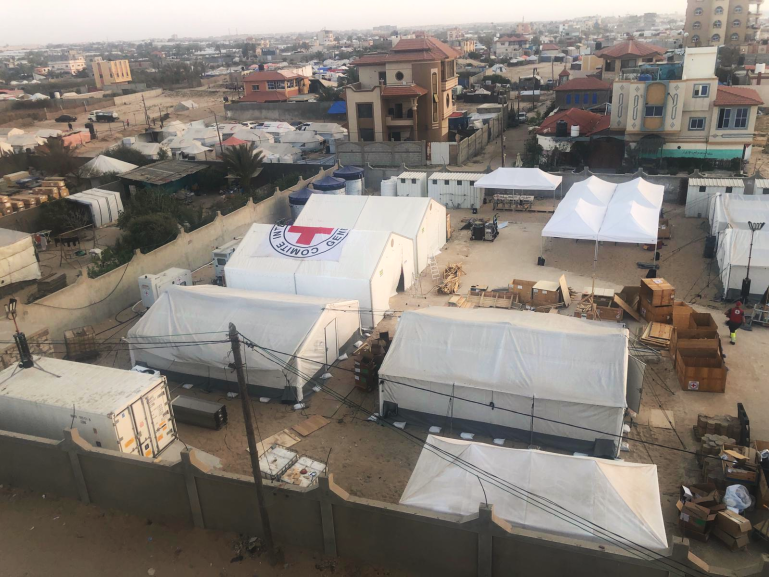The explosions are the cue.
Boom. And again: Boom.
I immediately know that a mass influx of patients is imminent.
On June 21, in the coastal area of al-Mawasi, on the southern end of the Gaza Strip, dozens of people were killed and scores injured when hostilities reached a displacement camp near the premises of the International Committee of the Red Cross (ICRC). Within minutes, the Red Cross field hospital next door, where I work as the senior medical officer, began receiving patients.
That afternoon, I had been sitting in the admin area of the hospital in a meeting about staffing and rosters when we heard a particularly loud explosion.
The wave of sound hit me. The hospital’s tent walls jerked as the shockwaves reverberated. We quickly realised what would be coming, and most staff – local Palestinians and foreigners – went to the emergency department to prepare.
But there was no time to prepare. In the chaos of war, you adapt.
I stood at the hospital entrance as ambulances came screeching in, at times sliding to a stop, with paramedics piling out to grab the stretcher, directing each patient to the appropriate area of our hospital, categorised by colour.
The red area: a young man with an arm dangling by threads of skin from the shoulder, shrapnel wounds across the chest and stomach. Immediate attention needed. Life at risk. Amputation likely.
The yellow area: a toddler screaming in pain, all limbs attached but a clear fracture, bleeding from shallow cuts. X-ray and splint required, maybe stitches.
The black area: a corpse, burned so badly as to be unrecognisable, wrapped in a sheet and sent to our morgue.
On this day, more than 50 wounded patients arrived at our field hospital, and despite our best efforts, eight of them died after their arrival. The bodies of 14 people, already dead, also were brought to us.
The doctors and nurses I work with aren’t strangers to what we call mass casualty events – critical situations that typically overwhelm the standard equipment and staff levels. Sadly, that week, we had three such events.
When they happen, we focus on the job at hand – treating those who need it. Inside hot tents, you analyse, you operate, you stitch.
Not far away are the gunshots and explosions, adding an element of fear for patients who have already lived through horror. Those who are conscious may be panicked or scared. Some are blank – in shock – or are yelling for family. Some need to be sedated.
After helping one patient, it’s on to the next bed. Assess, take readings, set a cast. Then the next. All around you, family members are screaming, people grieving, bystanders shouting. Staff, though clearly traumatised, continue working.

Six minutes until the patients arrive
People view hospitals – even ones made of canvas and tarpaulin – as havens of safety during war. Under international humanitarian law, hospitals are protected locations, so that those who need it can get medical attention and treatment.
In a place like Gaza, where no civilian feels safe, this creates a Catch-22 situation. People want to be close to the hospital, so they feel less exposed. At the same time, we have limited space and are trying to respond to large-scale emergencies where the lives of dozens are at risk.
Usually before a major influx of patients, you have time to gather staff and assign roles, set up triage beds and mass casualty kits with extra equipment, and give a quick situation update on what’s coming. But that week, because the explosions were so close to the field hospital, patients began arriving within six minutes.
The injuries were like those we have seen continually since the field hospital opened in mid-May close to the city of Rafah, and which have been seen across the entire Gaza Strip since October. Some can physically recover; some will live without a limb. But the mental toll, particularly for children, is so heavy it will remain for years to come. This is always a huge worry, and one that stays with me.
Some of those injured on June 21 will need more surgeries. Many will need physiotherapy and mental health support to recover.
After the patients have been attended to, we clean up, we repack the mass casualty boxes with fresh equipment, we speak to family members, and we debrief. The staff are traumatised by all they have seen but know the only thing they can do, for now, is attend to the patients still in the hospital and get as much rest as they can – before the next emergency.
EMEA Tribune is not involved in this news article, it is taken from our partners and or from the News Agencies. Copyright and Credit go to the News Agencies, email news@emeatribune.com Follow our WhatsApp verified Channel





